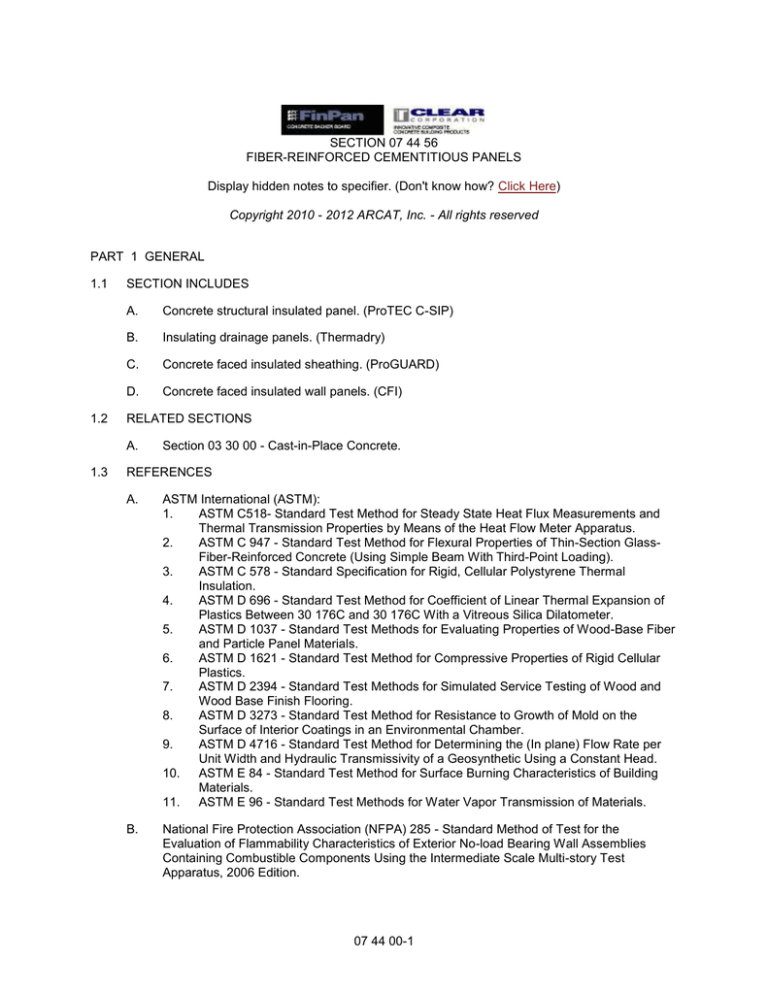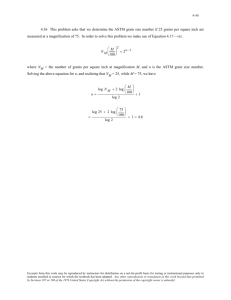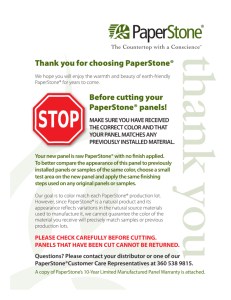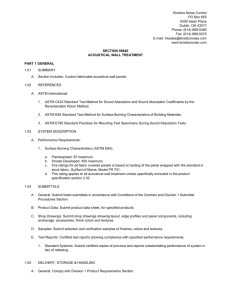
SECTION 07 44 56
FIBER-REINFORCED CEMENTITIOUS PANELS
Display hidden notes to specifier. (Don't know how? Click Here)
Copyright 2010 - 2012 ARCAT, Inc. - All rights reserved
PART 1 GENERAL
1.1
1.2
SECTION INCLUDES
A.
Concrete structural insulated panel. (ProTEC C-SIP)
B.
Insulating drainage panels. (Thermadry)
C.
Concrete faced insulated sheathing. (ProGUARD)
D.
Concrete faced insulated wall panels. (CFI)
RELATED SECTIONS
A.
1.3
Section 03 30 00 - Cast-in-Place Concrete.
REFERENCES
A.
ASTM International (ASTM):
1.
ASTM C518- Standard Test Method for Steady State Heat Flux Measurements and
Thermal Transmission Properties by Means of the Heat Flow Meter Apparatus.
2.
ASTM C 947 - Standard Test Method for Flexural Properties of Thin-Section GlassFiber-Reinforced Concrete (Using Simple Beam With Third-Point Loading).
3.
ASTM C 578 - Standard Specification for Rigid, Cellular Polystyrene Thermal
Insulation.
4.
ASTM D 696 - Standard Test Method for Coefficient of Linear Thermal Expansion of
Plastics Between 30 176C and 30 176C With a Vitreous Silica Dilatometer.
5.
ASTM D 1037 - Standard Test Methods for Evaluating Properties of Wood-Base Fiber
and Particle Panel Materials.
6.
ASTM D 1621 - Standard Test Method for Compressive Properties of Rigid Cellular
Plastics.
7.
ASTM D 2394 - Standard Test Methods for Simulated Service Testing of Wood and
Wood Base Finish Flooring.
8.
ASTM D 3273 - Standard Test Method for Resistance to Growth of Mold on the
Surface of Interior Coatings in an Environmental Chamber.
9.
ASTM D 4716 - Standard Test Method for Determining the (In plane) Flow Rate per
Unit Width and Hydraulic Transmissivity of a Geosynthetic Using a Constant Head.
10.
ASTM E 84 - Standard Test Method for Surface Burning Characteristics of Building
Materials.
11.
ASTM E 96 - Standard Test Methods for Water Vapor Transmission of Materials.
B.
National Fire Protection Association (NFPA) 285 - Standard Method of Test for the
Evaluation of Flammability Characteristics of Exterior No-load Bearing Wall Assemblies
Containing Combustible Components Using the Intermediate Scale Multi-story Test
Apparatus, 2006 Edition.
07 44 00-1
1.4
1.5
1.6
SUBMITTALS
A.
Submit under provisions of Section 01 30 00 - Administrative Requirements.
B.
Product Data: Manufacturer's data sheets on each product to be used, including:
1.
Preparation instructions and recommendations.
2.
Storage and handling requirements and recommendations.
3.
Installation methods.
C.
Shop Drawings:
1.
Include panels cut and numbered to match floor plan, elevations, sections, details of
components, details of penetration and termination, flashing details, joint locations
and configurations, fastening and anchorage details including mechanical fasteners,
and connections and attachments to other work.
2.
Show precut window and door headers and under-window panels.
3.
Show wiring chases and box openings.
4.
Show the hold down system for the Seismic & Severe Wind conditions.
5.
Provide schedule and sequence for the fabrication and loading for transportation
6.
Provide erection drawings that include drawings, diagrams, templates, instruction, and
directions, as required, for lifting, handling, placing, and installation of CSIP panels.
7.
Engineering calculations and drawings providing floor plans, window details, door
details, and connector details shall be submitted to the Architect.
D.
Selection Samples: For each finish product specified, two complete sets of color chips
representing manufacturer's full range of available colors and patterns.
E.
Verification Samples: For each finish product specified, two samples, minimum size 6 inches
(150 mm) square, representing actual product, color, and patterns.
QUALITY ASSURANCE
A.
Manufacturer Qualifications: Provides design, engineering, fabrications and testing of all
required components and assemblies for a complete system.
B.
Installer Qualifications: Fabricator Erector Qualifications: Certified in writing by CSIP
manufacture as qualified to erect manufacturer's CSIP panel system.
C.
Mock-Up: Provide a mock-up for evaluation of surface preparation techniques and
application workmanship.
1.
Finish areas designated by Architect.
2.
Do not proceed with remaining work until workmanship, color, and sheen are
approved by Architect.
3.
Refinish mock-up area as required to produce acceptable work.
DELIVERY, STORAGE, AND HANDLING
A.
Deliver materials in original packages with manufacturer's labels intact and clearly identifying
products.
B.
Store materials covered, dry and protected from weather, surface contamination, corrosion,
damaging temperatures, construction traffic, and the causes.
C.
Keep panels, steel components and fasteners protected from the elements prior to
installation.
D.
Store the panels laying flat.
E.
Do not drop panels.
07 44 00-2
F.
1.7
Store and dispose of solvent-based materials, and materials used with solvent-based
materials, in accordance with requirements of local authorities having jurisdiction.
PROJECT CONDITIONS
A.
Coordination installation of CSIP with related Work specified in other Sections to ensure that
wall assemblies, including flashing, trim, joint sealants, windows and doors, plumbing and
electrical.
B.
Field Measurements: Verify actual dimensions required for CSIP plans by field
measurements before fabrication and indicate measurements on Shop Drawings.
C.
Maintain environmental conditions (temperature, humidity, and ventilation) within limits
recommended by manufacturer for optimum results. Do not install products under
environmental conditions outside manufacturer's absolute limits.
PART 2 PRODUCTS
2.1
2.2
MANUFACTURERS
A.
Acceptable Manufacturer: T Clear Corporation / FinPan, Inc., which is located at: 3255
Symmes Rd.; Hamilton, OH 45015; Toll Free Tel: 800-544-7398; Tel: 513-870-9246; Fax:
513-870-9606; Email:request info (sconfer@tclear.net);
Web:www.tclear.com|www.finpan.com
B.
Substitutions: Not permitted.
C.
Requests for substitutions will be considered in accordance with provisions of Section 01 60
00 - Product Requirements.
CONCRETE STRUCTURAL INSULATED PANEL
A.
Product: ProTEC C-SIP as manufactured by T. Clear Corp.
B.
Performance:
1.
Impact Resistance (exterior facing): 2600 psi.
2.
Panel Weight: 4 lb/sf.
3.
Mold and mildew resistant materials-ASTM D 3273
4.
IBC - 2009: Listing Report: NTA TCC121205-17.
5.
IRC - 2009: Listing Report: NTA TCC121205-17.
6.
Passes 15 minute Corner Burn Test
7.
Moisture resistant skins and core.
8.
Long term insulation value: R-20.
C.
Construction: Sandwich panel of 2 lb/cf density expanded polystyrene as the core material
with light weight concrete backer board as the outer facings or skins.
1.
Exterior and interior panel facings shall be 1/4 inch (6.35mm) thick Util-A-Crete
Concrete Glass Fiber Mesh Reinforced Panels listed under NER-419 and
manufactured by Fin-Pan, Inc.
2.
Foam core shall be expanded polystyrene(EPS); 3.83 inch (97.28 mm) thick, nominal
2.0 pcf (32.04 kg/cubic m) density. Flame Spread Index (FSI) of 5 and a Smoke
Development Index (SDI) of 250-350.
3.
The adhesive used to bond the facings to the foam core shall be a moisture cure
urethane similar to Ashland 3030D and meeting the requirements of ICC-ES- AC-05.
4.
The fasteners shall be T Clear Drill tip, corrosion resistant #14-12 x 4-1/4" Dual
Thread, with a 5/8 inch (16 mm) diameter self drilling, square drive and #14-10x1-5/8
inch with a 5/8 inch (16 mm) pancake head square drive.
5.
Adhesive shall be Fomo Corp. expanding polyurethane as part of the connection
07 44 00-3
system to bond panels to the top and bottom track and to each other incorporating the
"H" Studs and "H/2" studs, or steel or wood tubes, studs or posts at the panel joints.
D.
2.3
Steel Structural Components:
1.
Top and Bottom Track: Minimum 20 ga. G-60 galvanized "U" shaped track nominally
2-5/8 inches (67 mm) OD (2-9/16 inches (65 mm) ID) web and 2 inches (51 mm)
vertical legs.
2.
Corner angle shall consist of 18 ga. G-60 galvanized steel with 2 inches (51 mm) legs
and length to fit the panel height.
3.
Half "H" studs ("H/2") shall be G-60 galvanized steel. The outside dimension of the
web shall be 2-1/2 inches (64 mm) and the legs shall be 2 inches (51 mm) long. One
end of the "H/2" is painted blue to distinguish it from the top and bottom track. The H/2
will fit snugly into the top and bottom track.
4.
"H" Studs consist of two H/2 studs that are factory spot welded together on the web. A
urethane sealing compound shall be applied to the web of the H/2 studs prior to
welding. The "H" stud fits into the bottom and top track and into the grooves of two
adjoining panels.
INSULATING DRAINAGE PANELS
A.
Product: Thermadry Insulating Drainage Panels as manufactured by T. Clear Corp.
B.
Performance: Type 750 - (25 PSI)
1.
Thickness: 1 inch (25 mm).
a.
R - Value (ASTM C518 - degree F-sf-h/Btu): 4.4
b.
Compressive Strength (ASTM D1621 - psf): 2160.
c.
Flow Rate (ASTM D4716 - gpm/ft at 500 lb per sf): 9.5.
2.
Thickness: 1-1/2 inches (38 mm).
a.
R - Value (ASTM C518 - degree F-sf-h/Btu): 6.9.
b.
Compressive Strength (ASTM D1621 - psf): 2160.
c.
Flow Rate (ASTM D4716 - gpm/ft at 500 psf): 9.5.
3.
Thickness: 2-1/4 inches (57 mm).
a.
R - Value (ASTM C518 - degree F-sf-h/Btu): 10.6.
b.
Compressive Strength (ASTM D1621 - psf): 2160.
c.
Flow Rate (ASTM D4716 - gpm/ft at 500 lb per sf): 9.5.
C.
Performance: Type 1250 - (40 PSI)
1.
Thickness: 1-1/2 inches (38 mm).
a.
R - Value (ASTM C518 - degree F-sf-h/Btu): 6.9.
b.
Compressive Strength (ASTM D1621 - psf): 3460.
c.
Flow Rate (ASTM D4716 - gpm/ft at 500 lb per sf): 12.
2.
Thickness: 2-1/4 inches (57 mm).
a.
R - Value (ASTM C518 - degree F-sf-h/Btu): 10.6.
b.
Compressive Strength (ASTM D1621 - psf): 3460.
c.
Flow Rate (ASTM D4716 - gpm/ft at 500 lb per sf): 12.
D.
Performance: Type 1750 - (60 PSI)
1.
Thickness: 1-1/2 inches (38 mm).
a.
R - Value (ASTM C518 - degree F-sf-h/Btu): 6.9.
b.
Compressive Strength (ASTM D1621 - psf): 5180.
c.
Flow Rate (ASTM D4716 - gpm/ft at 500 lb per sf): 12.
2.
Thickness: 2-1/4 inches (57 mm).
a.
R - Value (ASTM C518 - degree F-sf-h/Btu): 10.6.
b.
Compressive Strength (ASTM D1621 - psf): 5180.
c.
Flow Rate (ASTM D4716 - gpm/ft at 500 lb per sf): 12.
E.
Construction: A composite of insulation and fabric. Closely-spaced vertical and horizontal
07 44 00-4
channels on one side of the panel provide rapid drainage. The filtration fabric covering these
channels overlaps the adjacent panels both vertically and horizontally and prevents ingress
of soil particles into the drainage system. The panels are 2 feet by 8 feet (610 mm by 2438
mm), with tongue and groove edges all four sides, and are erected vertically.
2.4
2.5
CONCRETE FACED INSULATED SHEATHING
A.
Product: ProGUARD Insulated Sheathing Panels as manufactured by T. Clear Corp.
B.
Performance:
1.
Concrete Face:
a.
Compressive Strength-psi (ASTM D 2394):= 2600.
b.
Flexural Strength-psi (ASTM C 947): = 1500.
c.
Linear Variations with change in Moisture to air dry (50% RH, 73 degree F
(ASTM D 1037): Width 0.02%, Length 0.02%.
d.
Surface Burning Characteristics - Flame Spread (ASTM E84): 5.
e.
Surface Burning Characteristics - Smoke Developed (ASTM E84): 0.
f.
Weigh per SF (lb):1.98.
g.
Fastener Pull Through::= 195 lb.
h.
K-Factor: 1.6.
i.
R-Factor: 0.16.
2.
Extruded Polystyrene (ASTM C 578: Type X):
a.
Product: Dow Extruded Styrofoam Insulation (XPS).
b.
Density - lbs/cf: 1.3.
c.
Compressive Strength - psi: 15.
d.
R Value per inch (75 degree F mean temperature): 5 per inch.
e.
Water Absorption (% by volume Max): 0.30%.
f.
Water Vapor Permeance 1-1/2 inches: 0.733.
g.
Water Vapor Permeance 2 inches: 0.55.
h.
Surface Burning Characteristics - Flame Spread (ASTM E 84): 5.
i.
Surface Burning Characteristics - Smoke Developed (ASTM E 84): 165.
3.
Expanded Polystyrene (ASTM C 578 - 08b Type IX):
a.
Density - lb/cf: 1.8 Minimum.
b.
Compressive Strength - psi: 25 psi.
c.
R Value per inch- (75 degree mean temperature): 4.35 to 5.0 per inch.
d.
Water Absorption (% by volume Max): < 2% by volume.
e.
Water Vapor Permeance (Perm): < 2.5
f.
Surface Burning Characteristics - Flame Spread (ASTM E 84): 5 at 4 inches
thick.
g.
Surface Burning Characteristics - Smoke Developed (ASTM E 84): 40 to 100 at
4 inches thick.
C.
Construction: ProGUARD is a concrete faced exterior insulation consisting of 1/4 inch (6
mm) thick Util-A-Crete cement backerboard laminated to Dow Extruded Styrofoam or 2 lb/ cf.
Expanded Polystyrene in thicknesses of
1.
Overall panel thickness: 1-1/4 inches (32 mm).
2.
Overall panel thickness: 1-3/4 inches (45 mm).
3.
Overall panel thickness: 2-1/4 inches (57 mm).
4.
Overall panel thickness: 3-1/4 inches (83 mm).
5.
Overall panel thickness: 4-1/4 inches (108 mm).
CONCRETE FACED INSULATED WALL SYSTEM
A.
Product: Concrete Faced Insulated (CFI) Wall Panels as manufactured by T. Clear Corp.
B.
Panel Performance:
1.
Wall Panel System Fire Test:
07 44 00-5
a.
2.
Meets Uniform Building Code (UBC) 17-5 - Room Fire Test Standard for
Interior of Foam Plastic Systems. Criteria are to maintain coverage of foam
substrate up to 8 feet (2438 mm) from interior corner, over the duration on the
test.
b.
Equivalent to current UL 17-15 and UBC 97 revised.
Negative Wind Load And Gravity Shear Load Tests:
a.
Concluded that: ' Clips spaced at 2 feet (610 mm) along each horizontal joint
can safely carry the wall panel vertical weight and support the panel under
negative wind pressures of up to 25 psf, with a safety factor of 2.
b.
If greater wind pressures are anticipated, additional clips may be placed to
provide the additional strength.
C.
Construction: Perimeter Foundation Insulation: Extruded polystyrene board to ASTM C 578
(CAN/ULC-S701) Type IV, rigid, closed cell, with integral high density skin, c/w integral 5/16
inch (8 mm) thick latex-modified concrete facing.
1.
Board Size: 2 feet by 4 feet by 2-5/16 inches and 3-5/16 inches thick (610 mm by
1219 mm by 59 mm or 84 mm).
2.
Edges: Tongue and groove sides, square edge ends.
3.
Maximum Use Temperature: 165 degree F (74 degree C).
4.
Thermal Resistance (ASTM C 518): Long term aged R-value of 5 per inch (0.03 sm
K/W per mm).
5.
Foam Compressive Strength, ASTM D1621, minimum: 35 psi (240 kPa).
6.
Compressive Strength: to ASTM D 1621, minimum 40 psi (275.6 kPa)
7.
Water Absorption (ASTM D 2842): < 0.1 (0.7% by volume maximum).
8.
Water Vapor Permeance (ASTM E 96): 0.8 (50 ng/Pas m).
9.
Coefficient of Lineal Thermal Expansion ( ASTM D 696, in/in degree F (mm/m degree
C)): 3.5 x 10-5 (6.3 x 10-2).
D.
Accessories:
1.
Metal Cap Flashing: 24 ga (0.61mm) galvanized steel J-channel; 2-1/4 inches (57mm)
wide, 4 inches (102 mm) long leg and 2-1/4 inches (57mm) short leg; prefinished in
color as selected.
2.
Clips and Fasteners: corrosion-resistant type, sized to suit application; as supplied by
insulation manufacturer.
PART 3 EXECUTION
3.1
3.2
3.3
EXAMINATION
A.
Do not begin installation until substrates have been properly prepared.
B.
If substrate preparation is the responsibility of another installer, notify Architect of
unsatisfactory preparation before proceeding.
PREPARATION
A.
Clean surfaces thoroughly prior to installation.
B.
Prepare surfaces using the methods recommended by the manufacturer for achieving the
best result for the substrate under the project conditions.
INSTALLATION
A.
3.4
Install in accordance with manufacturer's instructions.
C-SIP (CONCRETE STRUCTURAL INSULATED PANEL) INSTALLATION
A.
Panel Connection
07 44 00-6
1.
3.5
The panels are fabricated with grooves in the insulation to install the Galvanized Steel
top and bottom "C" Channels, "H" Studs, "H/2" studs, and Corner Angles. The panels
are connected to these components by first injecting the Fomo Urethane Sub-Floor
adhesive into the panel grooves and the "web" between the grooves. The panels are
then placed in position, checked for plumb and level and then attached to the steel
components using the appropriate screw- typically the #14 x 4-1/4" Dual Thread screw
described above. There are 16 screws per panel - 1 in each corner and two at the
third point on each vertical edge and on both inside and outside surfaces of the panel.
B.
Exterior and Interior Wall Coverings:
1.
The exterior of the wall panels shall be covered with an approved exterior wall
covering as indicated on the drawings. The panel facings on the interior have a Class
A non- combustible interior finish rating.
C.
Openings:
1.
Openings up to 72 inches (1829 mm) in width, and having a minimum 13.5 inches
(343 mm) header depth, are permitted for door and window installations. Header
channels shall be installed and attached to the steel panel jamb C-Channels with two
No. 10-16 by 1/2 inch (13 mm) pan head self-drilling screws on each side of the
opening. All header panels shall be continuous, and installed on the header channel.
Top header channels shall be continuous over the opening and extend at least 6
inches (152 mm) over each side of the opening. Proprietary No. 14-10 x 1-5/8 inch
(41.3mm) wafer-head screws, spaced at 8 inches (203mm), are used to connect the
header panel to the steel header channel and steel top channel. A minimum of three
wafer head screws are used to attach the header to the vertical splines at each end of
the headers. Openings greater than 6 feet (1.8mm) and loads greater than those per
manufacturer's standard shall be designed by a registered professional engineer and
framed by conventional methods.
D.
Field Fabrication:
1.
Cutting the panel to reduce its width, cutting headers and window bases, and cutting
panels to accommodate special situations.
a.
Cutting of the panel will remove some or all of the factory installed slots
necessary for the installation of the steel components. These will have to be
replaced.
b.
When cutting a panel to reduce it width by 10 inches (254 mm) or less, make
the cut on the side where there is no vertical electrical chase.
c.
Headers cut for spans greater than 3 feet (914 mm) shall not contain an
electrical chase.
INSULATING DRAINAGE PANEL INSTALLATION
A.
Thermadry Foundation Wall Insulation:
1.
Surface should be smooth, monolithic and free of coarse aggregate. All debris should
be cleaned off footings. Waterproofing should be cured and free of solvent.
2.
Mastic adhesives compatible with the foam and the waterproofing shall be used in six
large, equally-spaced daubs on the non-fabric side of the panels to adhere them to
the cured waterproofing temporarily until the backfill is in place. Begin by installing the
first panel vertically, with the long edge flush with corner and the fabric flap on the
right. The fabric flap on the horizontal edge shall be at the bottom of the panel and
positioned to prevent backfill from entering the channels. Align the tongue of the
second panel into the groove of the first. Ensure the fabric on the long edge of the
panel overlaps the previous panel. Continue until a corner is reached. Cut and install
the corner panels. Use adhesive or staples to hold the flap in place. Additional loose
filter fabric shall be installed to assure that all gaps are covered.
3.
Multiple Tier Installation: Interlock the tongue and groove edges at both the horizontal
and vertical joints and ensure that the fabric flap of the upper panels overlaps the
07 44 00-7
4.
5.
6.
B.
3.6
3.7
lower panels. Use adhesive or staples to hold the overlapping fabric in place.
Top Edge Finishing: If the top edge of the panels is below grade, the edge shall be
sealed off to prevent soil entry, using a J- or Z channel, sheathing tape, or soil fabric.
Above Grade Installation: If the panels extend above grade, the exposed area shall be
protected from physical damage and from ultraviolet exposure with a mechanically
attached protection, such as pre-painted aluminum, vinyl, pressure-treated wood or
latex coating.
Completing the Drainage System: The panels shall be connected to a conventional
subsurface tile and gravel bed drainage system capable of carrying away water
drained through the channels of the panel.
Plaza Deck Installation:
1.
Where shown on the drawings and after the waterproofing membrane has been tested
and accepted by the architect, loose-lay the insulation panels over the water proofing.
(A thin film of water under the insulation will help it resist wind uplift during
installation.) Fit all joints tightly, with the fabric up and carefully overlapped at all side
and end joints. Provide temporary ballast if installation of the wearing surface is
delayed.
2.
Precast Concrete Pavers (Specified in related specification): Where shown on the
drawings, install the specified precast concrete pavers directly onto the insulation,
maintaining tight joints. Shim unsupported paver corners as necessary to prevent
rocking, using high density plastic shims.
CONCRETE FACED INSULATING SHEATHING INSTALLATION
A.
Steel and Wood Studs Application:
1.
Concrete Insulated sheathing shall be installed horizontally with the 8 feet (2438 mm)
dimension perpendicular to the studs. The layout shall permit the panel ship-lap joint
to fall on a stud line and fasteners should be placed 6 inches (152 mm) on center on
the panel joint. Field fasteners shall be placed a minimum of 6 inches (152 mm) on
the stud line if the studs are 16 inches (406 mm) or less on center and 4-1/2 inches
(114 mm) on center if the studs are 24 inches (610 mm) on center.
2.
Fastening Screws: The screws shall be self drilling and shall have a 5/8 inch (16 mm)
pancake head with either a square or star drive head. The screws shall be
Climacoated to resist weather corrosion and salt spray. The screws shall be supplied
by T. Clear Corp. in order to maintain the product warranty.
B.
Masonry Substrate Application:
1.
For installation directly to concrete block or poured concrete, masonry type fasteners
shall be used. Four 1/4 inch (6 mm) beads of a high quality, non-expanding, urethane
adhesive similar to "PL Premium" shall be applied to the foam side of the panel along
the four outer edges and at 12 inches (305 mm) from the long edge of the panel
running the full length of the panel. Fasteners shall be applied through the concrete
panel skin and foam insulation and into the masonry substrate. Fasteners shall be
placed 12 inches (305 mm) O.C. over the entire panel surface. The panel fasteners
shall have a weather resistant coating and all heads and panel joints shall be coated
with Water Armor.
2.
All joints shall be sealed with fiberglass mesh tape embedded in an approved
waterproofing compound similar to Water Armor as supplied by T. Clear Corp. Verify
compatibility with the exterior finish manufacturer.
CONCRETE FACED INSULATED WALL SYSTEM INSTALLATION
A.
Perimeter Insulation Substrate Examination (Poured Concrete or Concrete Block Only):
1.
Verify that the insulation boards and adjacent materials are compatible
2.
Verify that the substrate is flat, sound, clean and remove any masonry irregularities or
jagged surfaces on the foundation wall.
07 44 00-8
B.
3.8
Perimeter Insulation Installation:
1.
Layout concrete-faced insulation boards to maximize board sizes. Do not use boards
less than 6 inches (152 mm) wide.
2.
Install concrete-faced insulation board system in orientation as indicated or to
maximize full sheets. Complete with fastening clips and cap flashing in accordance
with manufacturer's installation guidelines.
PROTECTION
A.
Protect installed products until completion of project.
B.
Touch-up, repair or replace damaged products before Substantial Completion.
END OF SECTION
07 44 00-9



